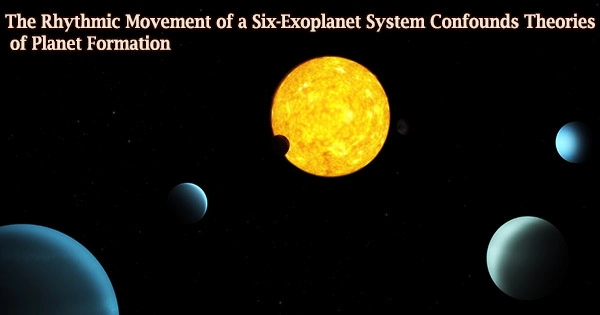Astronomers have discovered a system consisting of six exoplanets, five of which are locked in an unusual rhythm around their central star, using a combination of telescopes, including the European Southern Observatory’s VLT (ESO’s VLT). The researchers believe the system could provide significant details regarding the formation and evolution of planets, including those in our Solar System.
When the researchers first looked at TOI-178, a star 200 light-years away in the Sculptor constellation, they thought they saw two planets around it in the same orbit. A closer examination, however, revealed something quite different.
“Through further observations, we realized that there were not two planets orbiting the star at roughly the same distance from it, but rather multiple planets in a very special configuration,” says Adrien Leleu from the Université de Genève and the University of Bern, Switzerland, who led a new study of the system published today in Astronomy & Astrophysics.
According to new study, the system comprises six exoplanets, all of which, except the one nearest to the star, are locked in a rhythmic dance as they travel through their orbits. To put it another way, they are in sync. This means that when the planets orbit the star, there are patterns that repeat themselves, with some planets aligning every few orbits.
Three of Jupiter’s moons, Io, Europa, and Ganymede, have a comparable resonance in their orbits. For every round that Ganymede, Jupiter’s farthest satellite, performs, Io, the closest of the three, completes four full circles around Jupiter, and two full orbits for every orbit that Europa makes.
The TOI-178 system’s five outer exoplanets follow a far more complicated chain of resonance, one of the longest yet discovered in a planet system. The five outer planets in the TOI-178 system follow an 18:9:6:4:3 chain, with the second planet from the star (first in the chain) completing 18 circles, the third planet from the star (second in the chain) completing 9 orbits, and so on.
But even if the arrangement of the orbits is neat and well-ordered, the densities of the planets are much more disorderly. It appears there is a planet as dense as the Earth right next to a very fluffy planet with half the density of Neptune, followed by a planet with the density of Neptune. It is not what we are used to.
Nathan Hara
In reality, the scientists discovered only five planets in the system at first, but by monitoring this resonant rhythm, they were able to predict where an additional planet would be in the system’s orbit when they next had a chance to view it. This dance of resonance planets is more than simply an orbital oddity; it also reveals information about the system’s past.
“The orbits in this system are very well ordered, which tells us that this system has evolved quite gently since its birth,” explains co-author Yann Alibert from the University of Bern. If the system had been significantly disturbed earlier in its life, for example by a giant impact, this fragile configuration of orbits would not have survived.
Disorder in the rhythmic system
But even if the arrangement of the orbits is neat and well-ordered, the densities of the planets “are much more disorderly,” says Nathan Hara from the Université de Genève, Switzerland, who was also involved in the study.
“It appears there is a planet as dense as the Earth right next to a very fluffy planet with half the density of Neptune, followed by a planet with the density of Neptune. It is not what we are used to.”
For example, the planets in our Solar System are neatly ordered, with the harder, denser planets closer to the central star and the airy, low-density gas planets further out.
“This contrast between the rhythmic harmony of the orbital motion and the disorderly densities certainly challenges our understanding of the formation and evolution of planetary systems,” says Leleu.
Combining techniques
The researchers used data from the European Space Agency’s CHEOPS satellite, as well as data from the ground-based ESPRESSO instrument on ESO’s VLT and the NGTS and SPECULOOS telescopes at ESO’s Paranal Observatory in Chile, to explore the system’s peculiar architecture. Exoplanets are extremely difficult to detect directly with telescopes, therefore astronomers must rely on other methods to find them.
Imaging transits, which observe the light emitted by the central star as it dims as an exoplanet passes in front of it when observed from Earth, and radial velocities, which examine the star’s light spectrum for small signs of wobbles that occur as the exoplanets move in their orbits, are the two main methods used. The researchers employed CHEOPS, NGTS, and SPECULOOS for transits and ESPRESSO for radial velocities to observe the system.
Astronomers were able to learn a lot about the system and its planets by combining the two techniques. The planets orbit their central star considerably closer and faster than the Earth orbits the Sun.
The quickest (the innermost planet) completes an orbit in a few days, while the slowest takes ten times as long. The six planets range in size from one to three times the size of Earth, with masses ranging from 1.5 to 30 times that of Earth.
Some of the planets are rocky, however, they are classified as Super-Earths since they are larger than Earth. Others are gas planets, similar to our Solar System’s outer planets, but much smaller, and are dubbed Mini-Neptunes.
Despite the fact that none of the six exoplanets discovered are in the star’s habitable zone, the researchers believe that by extending the resonance chain, they may find other planets that are in or very close to this zone.
The ESO’s Extremely Large Telescope (ELT), which is expected to be online later this decade, will be able to image rocky exoplanets in a star’s habitable zone and even characterize their atmospheres, allowing researchers to learn more about systems like TOI-178.
















